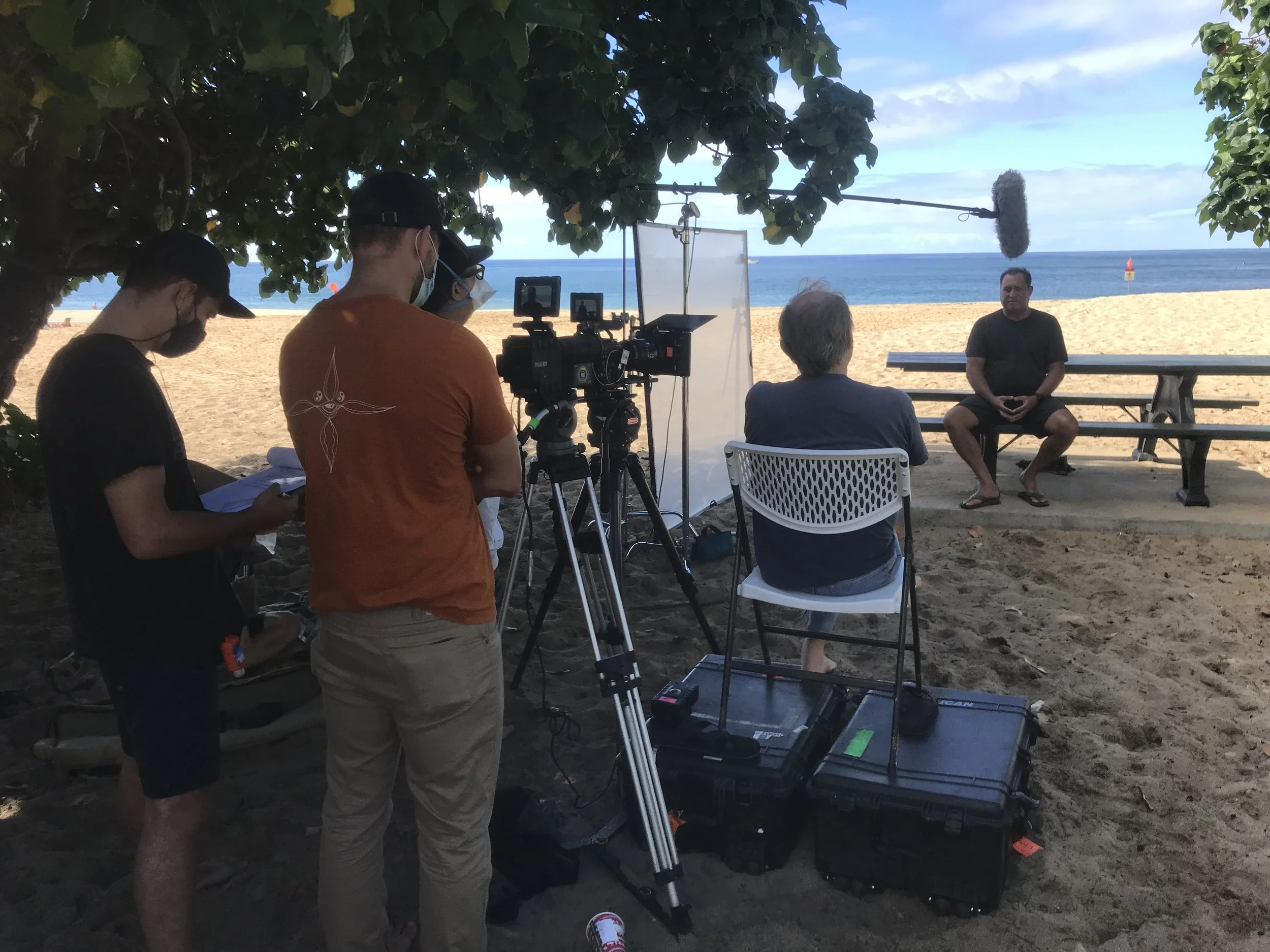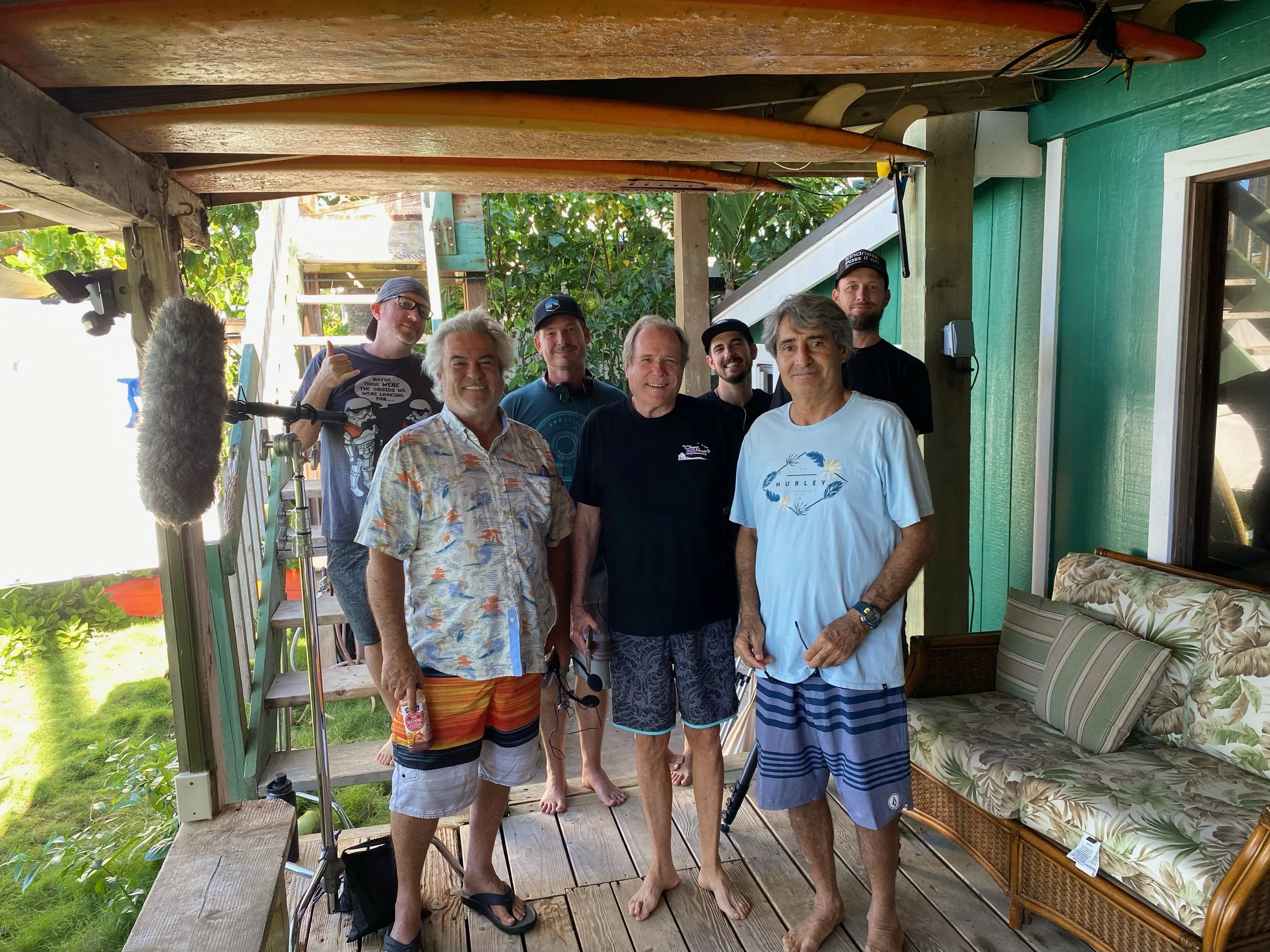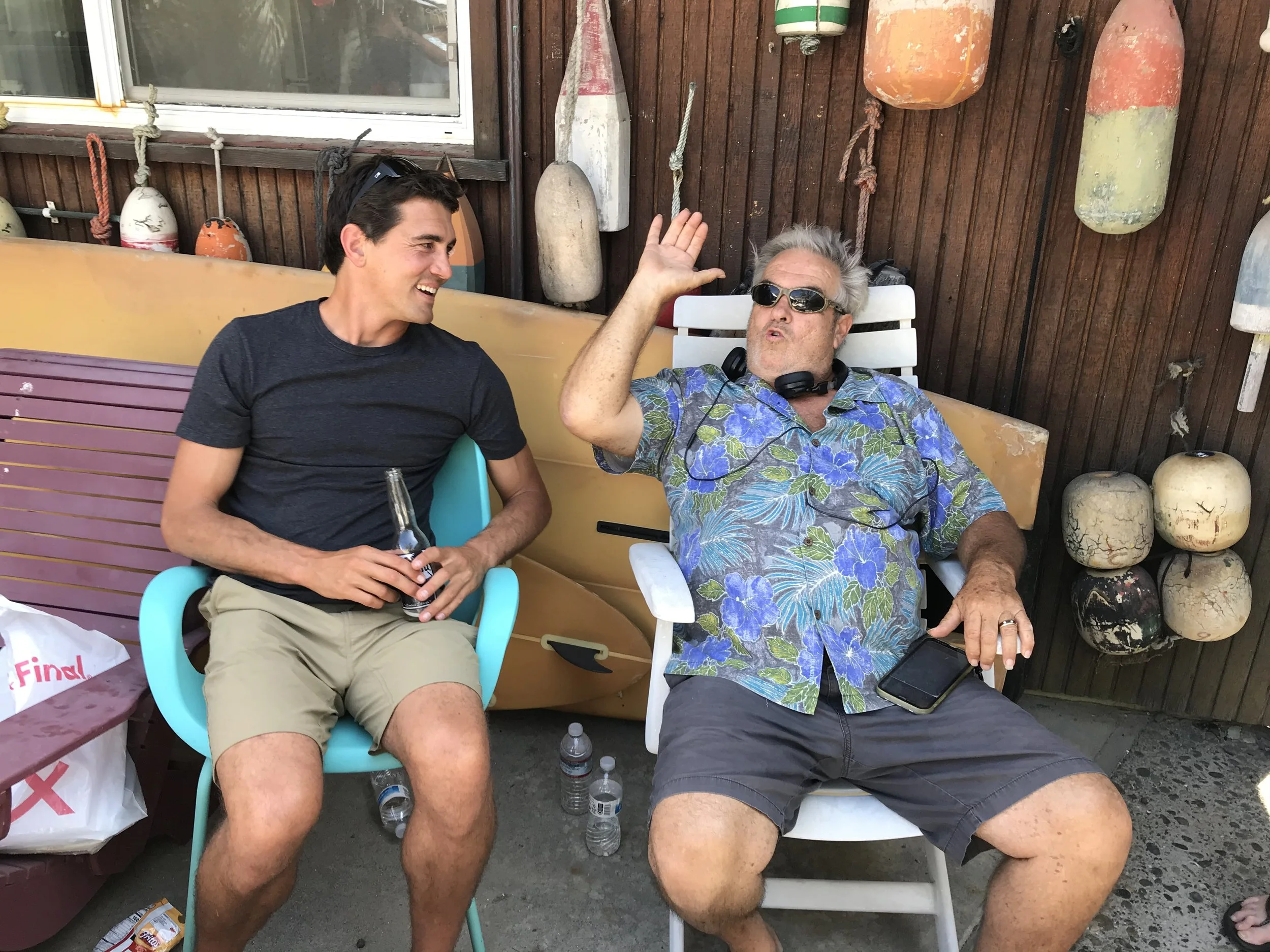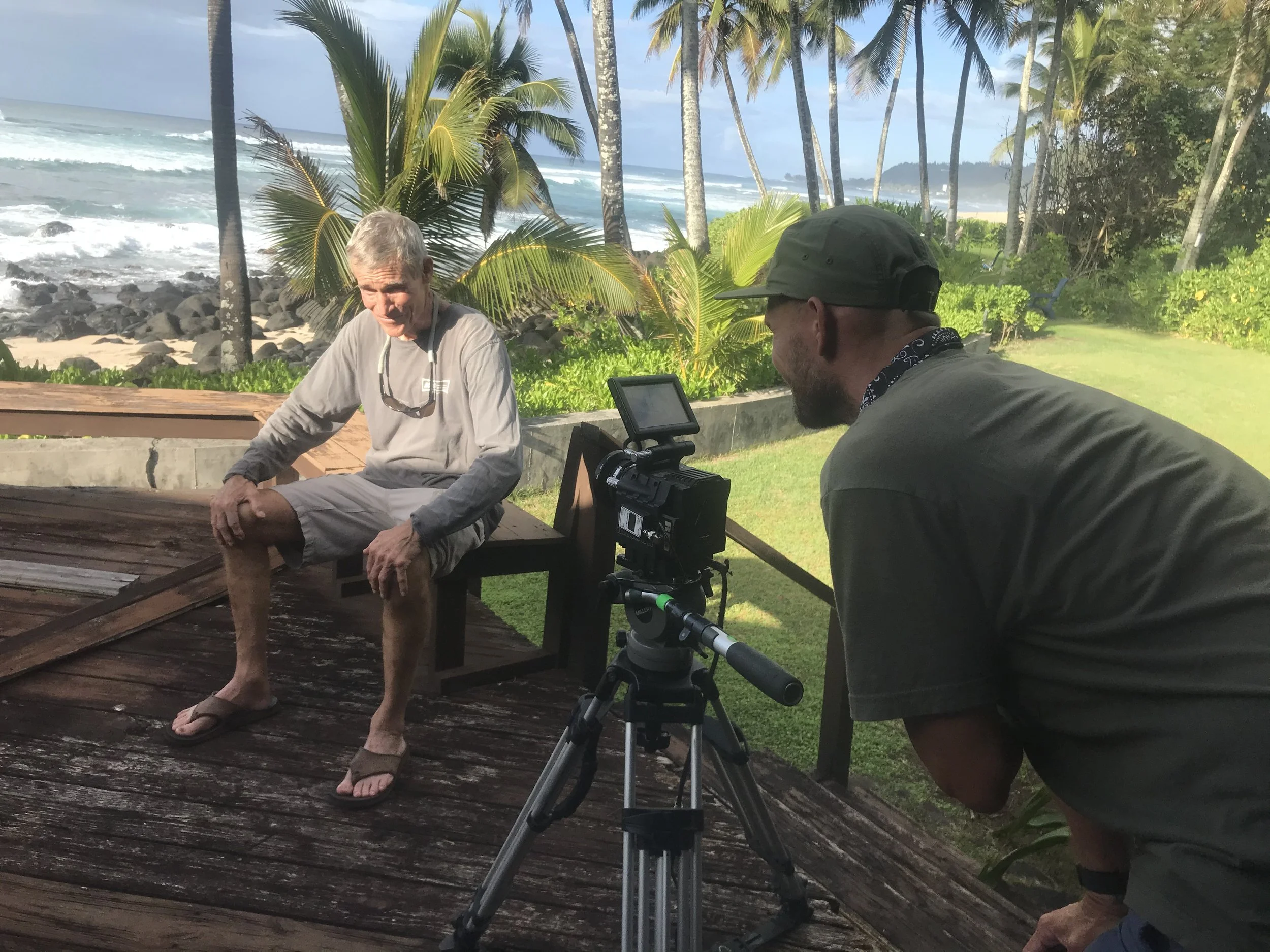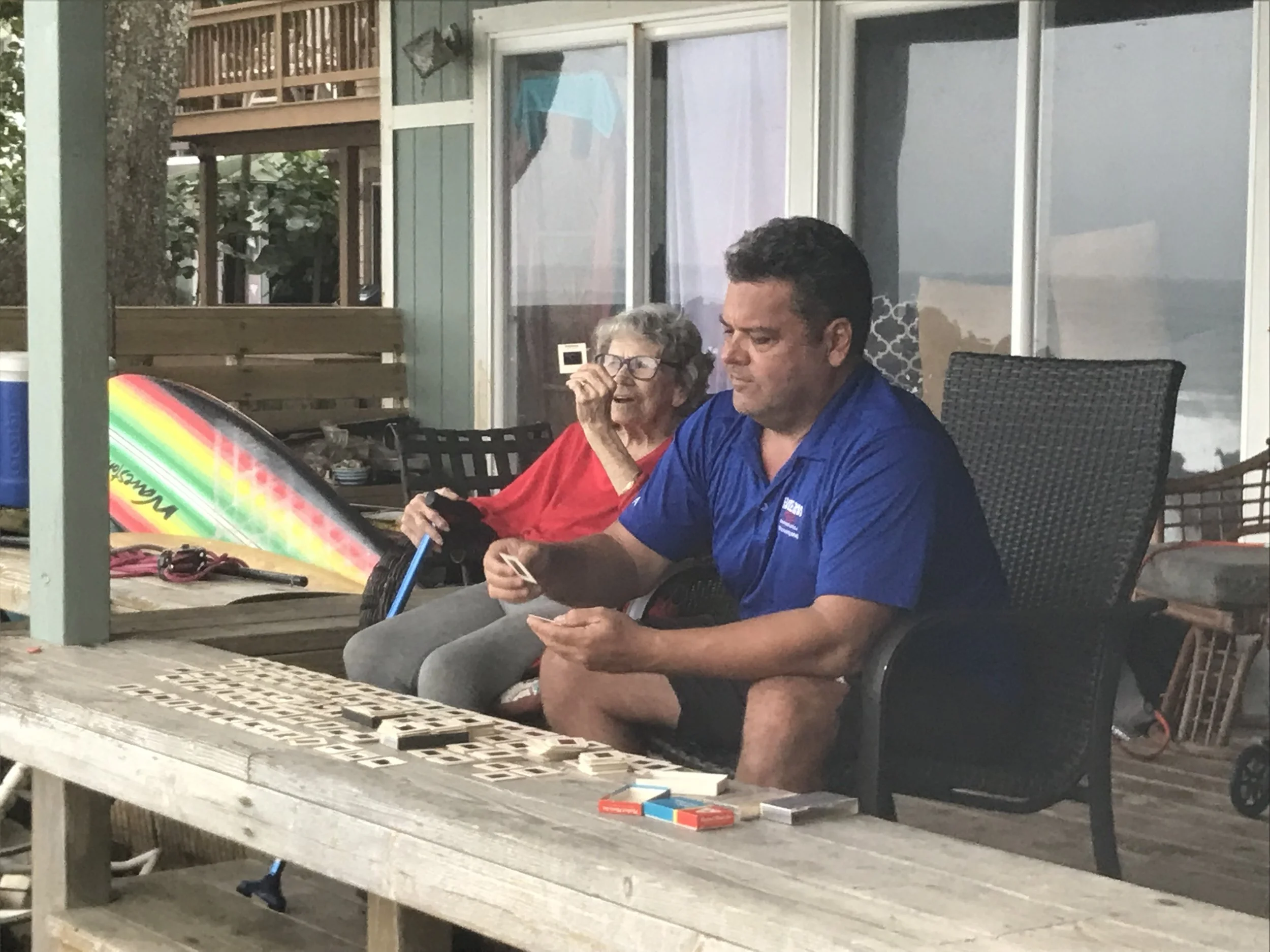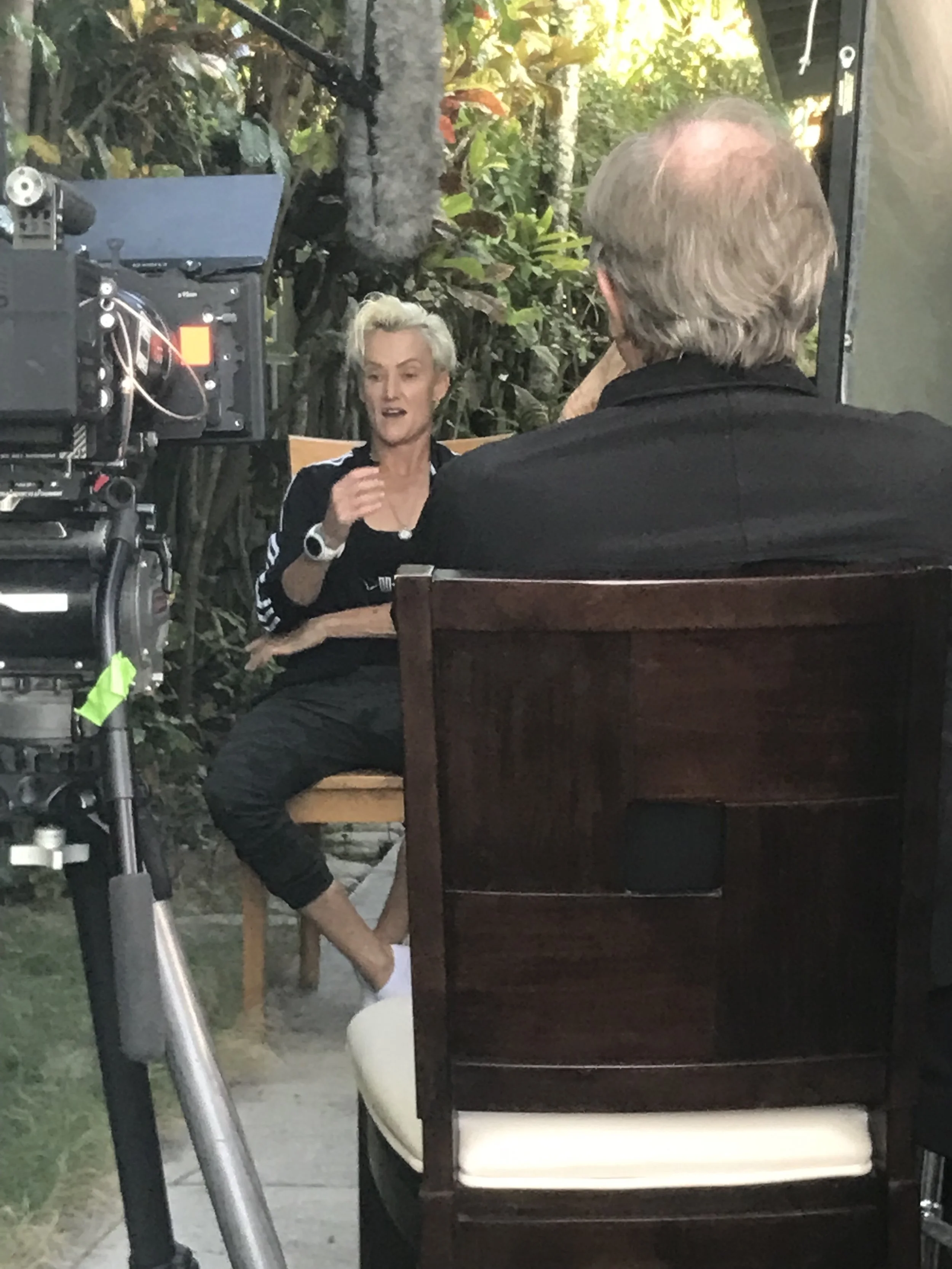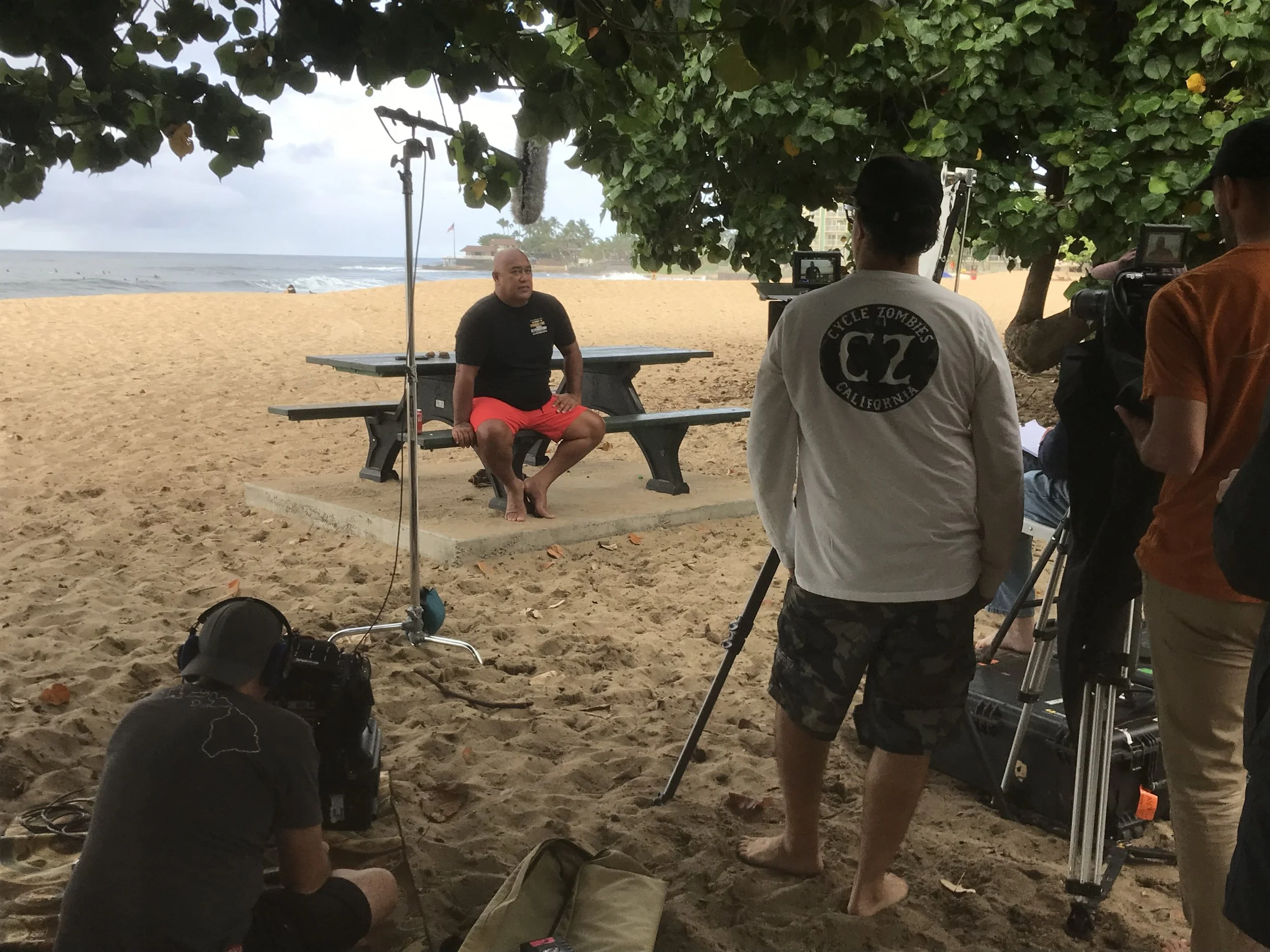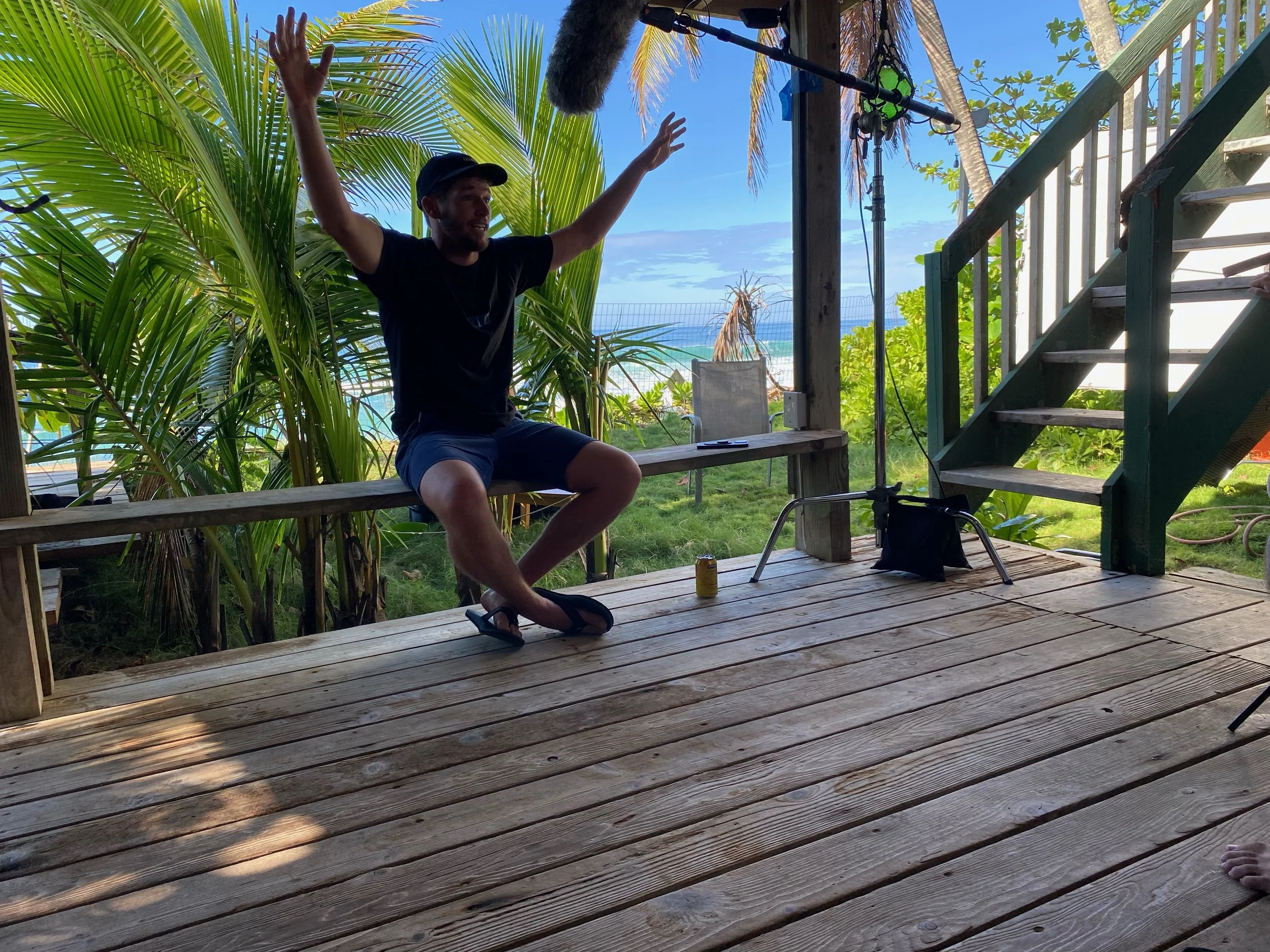While perusing Facebook at the end of June 2022 I learned my brother Dan nearly drowned on a Maui vacation while snorkeling at a place called Black Rock, in Kaanapali. Dan smokes and is not really a water guy, but he got into trouble while snorkeling, had trouble breathing and had to be helicoptered to a golf course, then ambulanced to the hospital where the doctors said he was lucky to be alive.
He felt lucky and was very impressed with the professionalism and efficiency of the Maui life savers - firemen and/or lifeguards.
We communicated and I congratulated him for surviving, suggested he stop smoking, sent him a news clipping about a 40 year old Californian who drowned in the same place two days later and also said I might know the guards who saved him, because I had interviewed Maui Lifeguard Captain Archie Kalepa for some Olukai stories when he was sailing on the Hokulea.
Having spent time in Hawaii going back to the late 1970s, and every winter with SURFER Magazine in the 1990s, and then living in Honolulu/Waikiki from 2014 - 2017, I am all too aware of how dangerous Hawaiian waters can be, how often locals and malihini get in trouble, and how dedicated to their tech and technique the Hawaiian lifeguards are. Especially the North Shore guards - who must keep a weather eye on two of the most perilous beaches on earth: Pipeline, and the Waimea Shorebreak.
I still get notifications from Hawaiian news stations and Facebook pages and Instagram, and it’s clear that people drown in Hawaii with shocking regularity. All the time, kind of like drownings in Texas and Oklahoma, and fatal car accidents in Malibu.
So with all that back story swirling I drove with three water wahine into Santa Monica on the night of June 29 to see a showing of Big Wave Guardians, a documentary about the Hawaiian lifeguards and the worldwide resonations of their heavy water techniques - from Duke and the Beach Boys in the early 1900s to Brian K and dem innovating the use of personal watercraft to pull drowning citizens from Davy Jones Locker.
I invited all the lifeguards I know, past and present: LA County guard Gene Rink, former Santa Cruz lifeguard present Baywatch Catalina Captain Jay Butki and Rabbi Nachum Shifren.
Those guys all showed face and I also saw in the crowd Rory Russell (?!) and Allen Sarlo and various other rogues and rascals from the surfing and ocean worlds.
And oh yeah, duh: Speaking of rogues and rascals, Marty Hoffman was there, because he Executive Produced the movie with Greg and Shaun MacGillivray and Scott Bradfield.
Didn’t know Marty Hoffman was a movie producer, but he done good.
It was fitting and proper to see Big Wave Guardians on a big screen, from the second row, as you could feel and hear the power of the ocean - because ocean power is what this documentary is all about: Ocean power overpowering humans, and other humans dedicated to empowering themselves to on powered vehicles to rescue overpowered humans from ocean power.
BEHIND THE SCENES OF BIG WAVE GUARDIANS
Big Wave Guardians goes deep into history, like foam explosions at Pipeline, swirling around the foundations of Hawaiian lifesaving going back to the early 20th Century: Specifically, the surfer/waterman/lifeguards of the Hawaiian Islands, going back to Duke Kahanamoku and the Hawaiian Beach Boys showing tourists the secrets of the sea, and then the evolution over the last 120 years: Duke up to mid-century, then Buffalo Keaulana, Jose Angel out of the 50s, then Eddie and Clyde Aikau from the 1970s and then in the late 20th Century, Herbie Fletcher, Tony “Squidy” Sanchez, Brian Keaulana, Mel Puu, Terry Ahue, Archie Kalepa, Darrick Doerner and dem discovering how useful standup Jet Skis, rescue sleds and Personal Watercraft can be to get fast access to the impact zone, grab a struggling surfer and pull them to safety.
One of the many quotes from the movie that stuck: “What used to take an hour, now takes minutes.”
Using machines for ocean rescues is the fulcrum of this story: All the Hawaiian lifesaving that preceded it was made much much easier in the late 1980s, and much of what has happened since in big-wave surfing and ocean rescue has been changed dramatically by the innovation of PWC in the surf. Those techniques have been handed through Y2K to all of the Hawaiian Islands and to tuned-in water safety services around the world - from Alaska to Zanzibar.
Big Wave Guardians is beautifully shot by land, sea and air. The story begins at Makaha, with some cool drone shots showing the whole deal from on high - the God’s eye view - then moving down to sea level to explain how that most-Hawaiian corner of Oahu is one of the experimental calabashes of Hawaiian ocean rescue, with Buffalo Keaulana passing the baton to his son Brian.
This segment features a now-famous 1993 rescue of a honeymooning tourist who got washed off a cliff at the Moi Cave up along Kaena Point, past Yokohama. The surf was big and this tourist was in the deepest kimchi - washed into a razor sharp cave and stuck there for two and a half hours, while Brian K and others hovered outside this blowhole, thinking: “Should I stay or should I go now?” as they pondered a lot of water and energy rushing into a cave, where a human was trapped and terrified.
They hover outside the mouth of the cave on a PWC, dodging waves and backwash until the tourist honeymooner gets washed out and rescued by the skin of his fingertips.
That malahini honeymooner dude is alive by grace of PWC x experience x teamwork. He was in deep deep trouble.
A truly harrowing rescue that is one of the foundations of the use of PWC in rescues.
The second segment of BWG could be called Guards Just Wanna Have Fun as it shows the reality of being a Hawaiian lifeguard - and specifically a North Shore lifeguard - in the 21st Century. Active and emeritus guards like Dave Wassel and Mark Cunningham explain that they might not ever get rich, but it’s better than digging a ditch. They love getting paid to be at the beach every day, but they are dead serious about the deadly nature of their jobs. All too aware that anyone from Kentucky Tourist to Kelly Slater could get hurt at any minute.
Anyone who has spent any time at all surfing or bodysurfing or swimming around at Pipeline or Waimea Shorebreak thinks the same thing: “How do people not drown or die here every day?”
The North Shore lifeguards are why. They are trained, they are physically fit and they all know it’s all about teamwork, preparation, experience.
From contemporary lifeguards in the 21st Century, BWG goes back to 1901, to the evolution of tourism in the Hawaiian Islands and the corps of Beach Boys - another bunch of fun-loving guys who got paid to be at the beach, whose job it was to introduce malahini to the Secrets of the Sea - and keep them safe. People like Tom Blake, George Freeth and Duke Kahanamoku innovated lifeguard tubes, paddle boards and other tech and techniques, that sped up the response time and rescue rate back then, the way PWC have sped up the process now.
Of course, of all those Beach Boys, Duke Kahanamoku is the best known, as he used his fame as a gold medal Olympic swimmer to travel the world as a celebrity, introducing surfing and ocean safety from Australia to Venice Beach.
BWG is very good at giving credit to where it’s due - to people like Squidy and Herbie - but if there is one historic point that was overlooked in this documentary, it was leaving out Hawaii-trained Beach Boy George Freeth traveling to California and essentially launching the mainland lifeguard service in the South Bay.
Kind of a big oversight, which was explained by writer Jim Kempton:
Didn't overlook Freeth. He was in deep on the original cut. He is mentioned along with Blake in the history section. But everyone said we had too much "history" so we shortened that section up and since he was not one of the characters who reemerge in the final act of the film (like Eddie, Duke, Jose, etc) we just couldn't keep him in for more than a mention. The tragedy of limited story-telling!
So they skipped over Freeth a bit, but give Duke Kahanamoku justifiable cred as the Hawaiian who began the influence of Hawaiian lifeguards around the world - a tradition that evolved through the rest of the 20th Century and is going strong today.
This segment explains how the Royal Hawaiian Hotel was the first to utilize a trained team of water safety experts. That leads into the 1950s, when surfers on better equipment began prowling the rest of Oahu for waves and adventure, and that led to the North Shore - where mid-century Hawaiians and visitors re-discovered what the ancestors knew - North Shore is the place.
There are a lot of credible, experienced akamai talking heads talking story in Big Wave Guardians - old and new - and the North Shore segment starts with Keala Kennelly and Andrea Moller explaining why the waves of the North Shore are so powerful, and that’s picked up by Bryan Phillips and Kerry Atwood and a lot of others explaining why these islands out in the middle of the Pacific with no continental shelf create such great conditions for surfing, and such dangerous conditions for swimmers.
That leads to a longtime North Shore resident Johnny Angel, who has been surfing and rescuing since he was a keiki. Lots of stories about rescues Johnny was involved in and the lives he saved, and that leads back to Johnny’s famous father, Jose Angel - a mainlander who moved to Hawaii in the 1950s with the love of his life, and became one of the legends in Hawaiian surfing and life saving.
Jock Sutherland explains how Jose Angel would swim out at Pipe just to take beatings, and do back flips into the pit at Waimea just for grins.
Dave Wassell explains how Jose Angel invented outer reef surfing, but during a time when they were absolutely on their own - get in trouble and you had to save your own okole.
Jamie O’Brien, Kohl Christenson and Johnny Angel are all aware of the path blazed by Jose Angel as a surfer, diver, waterman and rescuer, and that aura hovers around the North Shore - in the decades after Angel died too young diving for black coral.
From Jose Angel to the Eddie Aikau Big Wave Invitational, and that leads to another Hawaiian legend whose activities in the second half of the 20th Century continue to inspire surfers, watermen and lifesavers in the 21st.
Clyde Aikau, O’Shaughnessy, Dave Wassel, Kelia Moniz and many others explain who Eddie Aikau was, where he came from and what he did. Believe it or not, at one time, Eddie Aikau was the only lifeguard on the entire North Shore, which would be like one lifeguard responsible for everything from Topanga to Zuma Beach, or one lifeguard responsible for everything from Capitola to Natural Bridges.
Eddie did his job mostly solo, with not much more than swim fins and a rescue tube in a hearse painted white. Eventually Eddie would have some backup with his brother Clyde, who explains how many rescues they did, how many lives they saved and gets the biggest laugh when he describes pulling people from Tennessee out of the shorebreak at Waimea Bay.
According to Big Wave Guardians, with Eddie and friends on duty, from 1967 to 1978 not a single life was lost on Eddie’s watch.
The focus of the surfing world moved from Waimea Bay to Pipeline out of the 1960s into the 1970s, as surfboards got shorter and surfers got quicker - and Pipeline presented a whole new set of problems, because this is one place that absolutely lives up to the hype for being dangerous.
Mikey O’Shaughnessy, Keala Kennelly, Tamayo Perry, Moana Jones and many others explain how Pipeline is the world’s deadliest wave, and how it is now the primary focus of the surfing world.
The Pipeline lifeguard towers are possibly the most active lifeguard towers in the world when Pipe is breaking, and the guards there are trained and on their toes, because someone could get hurt at any moment.
Kohl Christenson is an experienced Pipe surfer who details his accident there - getting knocked unconscious when a wave bottomed out and he smacked his head on the bottom. He was unconscious and face down, but there were four PWC in the channel, and everyone came to his rescue.
This section stresses how teamwork is now the theme of the place where Eddie Aikau used to patrol alone. Teamwork gets it done.
From Pipeline to lifeguard headquarters at Haleiwa, and a detailed evolution of the machines hovering in the channel at Pipe that saved Kohl Christenson’s okole and so many others going back to the late 1970s, when visionaries like Squidy and Herbie Fletcher began zipping around the North shore on stand up jet skis.
Brian K, Terry Ahue, Darick Doerner look back to a time when all they had were swim fins, a rescue tube and a helicopter that had to fly all the way from Honolulu for rescues.
When someone was getting sucked out in the rip at Sunset or Haleiwa, it could take longer than an hour to reach them and rescue them.
And as this story goes, at some point Brian Keaulana wiped out on a big wave and was going blub blub blub when Squidy came into the impact zone on a ski and saved his bacon.
At that point, a light bulb went off over Brian’s head, and the most important evolution in Hawaiian lifeguarding - and worldwide water safety - began with Brian K, Terry Ahue, Mel Puu and others reading magazines, talking to people and figuring out the best machines for getting in and out of the kukai as fast and safely as possible.
The story explains how the use of PWC cut rescue time down from over an hour to a couple of minutes. But that caused problems in Hawaii: Brian K and others got fined for using machines in the surf zone, and they had to do a demonstration in front of the City Council. They dropped a Council member in the impact zone, he started struggling, and they zipped in and saved him.
And that was that. Game on.
One thing lead to another, and the use of PWC for water rescue paralleled the use of PWC to catch bigger and bigger waves, and that called for water drivers to improve their skills as they went zooming into the zone at Mavericks and Teahupoo and Cortes Bank and a lot of heavy water places - saving surfers and civilians from Davy Jones Locker.
Aided by finely-accurate surf reports, Internet travel connections and other tech and everyone with an eye on the XXL money, lots of surfers were spanning the globe chasing bigger and bigger waves. Big Wave Guardians focuses on Mark Healey, Kohl Christenson, Nathan Fletcher and Sion Milosky, and that leads to the irony that even with all that experience and talent and hovering machines, talented watermen can still drown as easily as Dickie Cross at Waimea in 1947, Mark Foo at Mavericks in 1992, Jay Moriarity in the Maldives in 2001 Malik Joyeux at Pipeline in 2005 and a lot of close calls, like Greg Brown at Cortes Bank.
Sion Milosky drowned on a late Mavericks swell in March of 2011. He wiped out, got held down for two waves, and drowned. Like with Foo, his body was found by the mouth of Half Moon Bay Harbor. No one saw him drown, or noticed him missing.
That story is recounted by Greg Long, photographer Daniel Russo and Kohl Christenson. He left behind a wife and two daughters.
BWG mentions the deaths of Jose Angel and Eddie Aikau as experienced watermen who drowned in action, but leaves out Mark Foo, Donnie Solomon and Jay Moriarity. Milosky’s death at Mavericks was as big a shock as Mark Foo drowning there in 1992, and maybe bigger. Because everything was in place and tuned, the ocean still got him and no one saw it go down.
Daniel Russo said, “We can’t let this happen again. This is just too much.” and Danilo Couto introduce the next segment:
“With the passage of Sion, came a feeling of… very angry with the whole system. How can one of the best of the sport - using flotation vest, having sponsors, having all the group of people in the water.. How come he’s the one laying down over here? Clear answer: There’s no protocol, there’s no system, you know? That experience was very unsettling for me.”
Danilo reached out to Sion’s friends and family, who reached out to Brian Keaulana to develop a program that laid down the protocols and system that failed Sion.
The narrator continues: “Brian and the team formed what would become known as BWRAG - Big Wave Risk Assessment Group, geared toward equipping the public to make the ocean safer for everyone. What started in Kohl’s garage as a simple CPR class with a dozen people, quickly grew into a comprehensive, ocean safety education movement.”
How to extract someone from the water, with and without a PWC. How to do CPR. How to do medical care on the beach. How can we prevent that, by looking at the currents. Controlling your breathing. Energy management. Awareness with each other.
Brian agreed to do it if the group would share the lessons around the world. And they did, and all the members of BWRAG know there are many many people still breathing around the world because of the lessons of their group - inspired by the drowning of Sion Milosky.
Mikey O’Shaughnessy is one of those who was rescued by Team BWRAG after a wipeout at Pipeline.
The story returns to Eddie Aikau and the Eddie Aikau Big Wave Invitational. The first event was in 1986, and there is talk of some sea turtles that might have been the spirit of Jose Angel and Eddie Aikau, who led Clyde Aikau into some bombs during that contest on a difficult day.
Clyde won the first one and surfed in the Eddie all the way up to 2016, when Clyde at 66 paddled out into the infamous Brock Swell which was swatting everyone equally.
(That definitely was Brock calling the shots from Surfer Valhalla for that contest. Anyone who knows Brock’s kolohe spirit knew he was up there laughing.)
This is worth watching. The whole thing. Duke K on This is Your Life. Humble hero. Pure Hawaiian. Cool guy.
The story detours to Duke Kahanamoku who was featured on This Is Your Life, a popular show in the 1950s. The show is a surprise and Duke was further surprised when they brought out three guys who Duke rescued at Corona del Mar in 1925. Saved their lives, and 30+ years they were still grateful.
The point here is that people don’t often thank lifeguards the way they should: Out of embarrassment or fear of showing weakness or trauma, they don’t know how to muster the courage to thank their saviors.
Big Wave Guardians ends with a classy touch: Kohl Christenson, Kalani Chapman, Hayden Rodgers, Mikey O’Shaughnesst, Steven Ing, Greg Long, Hayden Rodgers’ parents, Alex Gorman and Dusty Payne publicly thanking the lifeguards and citizens who rescued them and enabled them to keep breathing.
Powerful surf, lovely music, beautiful cinematography, talking heads talking story, akamai knowledge of Hawaiian and surf and water rescue history. Big Wave Guardians is a quality project that gives credit to life savers who are often overlooked.
This documentary will inspire different people in different ways. But it inspired me to email Archie Kalepa and thank him and his guys for rescuing my brother on Maui. And I suggested my brother Dan contact him too.

